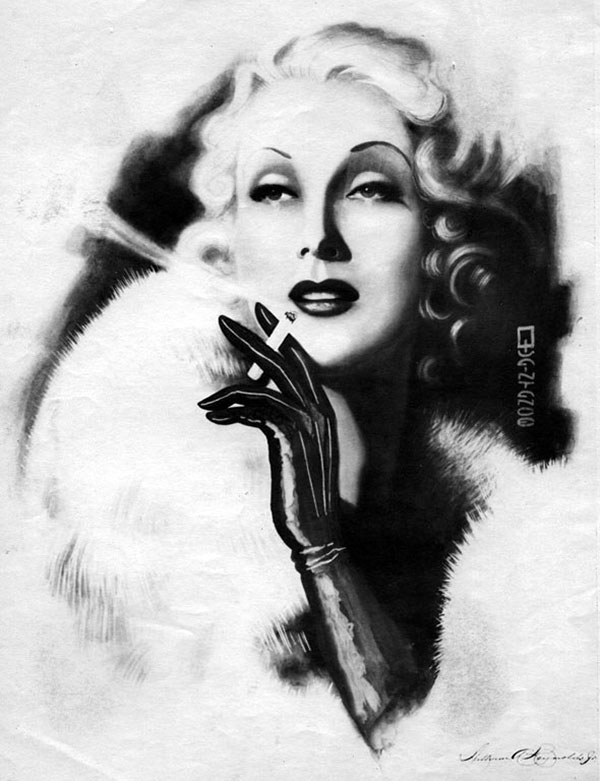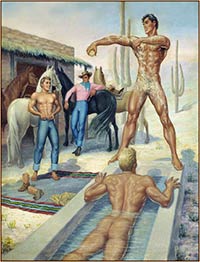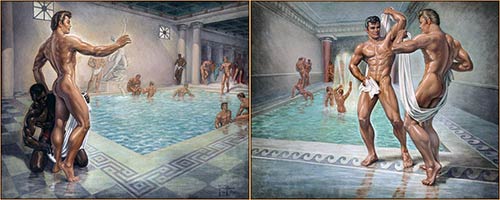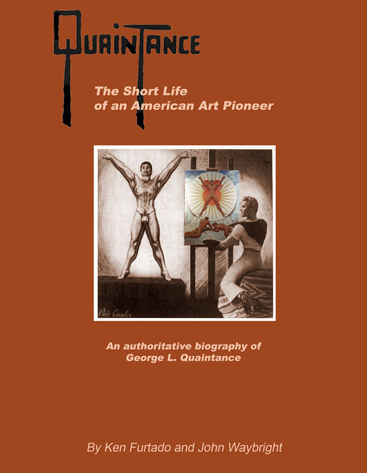- Details
- Written by: Ken Furtado
After posting the previous entry, I remembered a 2009 conversation I had with the nephew of Victor Garcia. I will call him Fermin, as he does not wish me to use his name. Victor was George's romantic partner long before the founding of the Quaintance Studio. After George and Victor ceased to be lovers, Victor remained George's business partner and principal studio photographer, and he co-inherited the Quaintance estate.
Fermin told me that, as a child, he and his sister and mother (Victor's sister, Josefina) would visit George and Victor in their New York City apartment. The painting Kanaka Fisherman was hanging over the mantelpiece, and Fermin and his sister would giggle at it and call it "the nakedy man."
- Details
- Written by: Ken Furtado
 A visitor to this blog recently wrote to ask me about an original Quaintance canvas he owns. He enclosed snapshots. Lo, it was Kanaka Fisherman, but it was a fisherman I have never seen.
A visitor to this blog recently wrote to ask me about an original Quaintance canvas he owns. He enclosed snapshots. Lo, it was Kanaka Fisherman, but it was a fisherman I have never seen.
Two other versions of Kanaka Fisherman are known. One of them bears a 1940 date and the vertical signature. In it, the man is throwing a net. This painting (center image in photo) belongs to a collector in Los Angeles and it was purchased directly from the Quaintance estate in the 1970s. The canvas orientation is horizontal.
- Details
- Written by: Ken Furtado
 Quaintance was his own best promoter, and one of the things he promoted himself as was a muralist. But where are the murals?
Quaintance was his own best promoter, and one of the things he promoted himself as was a muralist. But where are the murals?
There's one for sure: it hangs over the baptismal font at the Stanley, Virginia Baptist Church that his mother attended. Quaintance painted it at her request, with the blessings of the church, and it's there today for all to see. It depicts life-sized figures of John the Baptist holding the hand of Jesus and leading him into the River Jordan. Six male figures are prostrate on the shore, including an anomalous jungle boy wearing a tiny loincloth.
Quaintance was also said to have painted the mural adorning an entire wall of Mae West's boudoir, at her 7,500-square-foot Santa Monica beach house. The residence was considered to be an art deco masterpiece, but the mural was destroyed during remodeling after West sold the property. I have a poor, foreshortened snapshot of the mural. It does not appear to be the work of Quaintance.
- Details
- Written by: Ken Furtado
 Quaintance executed many drawings of women — mostly nudes — that were published as lithographs. The smoking woman, clearly a femme fatale, is seldom seen. I have only a photograph of it, so I cannot comment upon the dimensions, color or date. Quaintance's signature appears clearly in the center right, and "William A. Reynolds Jr." appears in ornamental script at the bottom.
Quaintance executed many drawings of women — mostly nudes — that were published as lithographs. The smoking woman, clearly a femme fatale, is seldom seen. I have only a photograph of it, so I cannot comment upon the dimensions, color or date. Quaintance's signature appears clearly in the center right, and "William A. Reynolds Jr." appears in ornamental script at the bottom.
- Details
- Written by: Ken Furtado
 During Quaintance's lifetime, the U.S. Supreme Court had yet to come up with the Miller Test for obscenity, and nearly anyone who was offended by an image could declare it obscene. It was usually OK to show a male model's buttocks but frontal nudity was a big no-no, as was any suggestion of homoeroticism. Even if a male model wore the ubiquitous posing strap, "excessive genital delineation" could be cause for legal trouble.
During Quaintance's lifetime, the U.S. Supreme Court had yet to come up with the Miller Test for obscenity, and nearly anyone who was offended by an image could declare it obscene. It was usually OK to show a male model's buttocks but frontal nudity was a big no-no, as was any suggestion of homoeroticism. Even if a male model wore the ubiquitous posing strap, "excessive genital delineation" could be cause for legal trouble.
Having spent 1947 in jail for using the mail to distribute "obscenity," Physique Pictorial publisher Bob Mizer employed legal advisers to avoid future errors in judgment when deciding what images could be safely published in his hugely popular magazine. Quaintance's imagery and advertising were a mainstay of Physique Pictorial in its early years, but when the painting Morning in the Desert was selected for the cover of the Feb. 1952 issue, there needed to be some changes.
- Details
- Written by: Ken Furtado
 The next two lithographs were printed simultaneously: Baths of Ancient Rome and Spartan Soldiers Bathing. These were smaller than the previous pair, with the actual print area measuring 14x11 inches. Only 10 of Quaintance's 54 canvases of the Male Physique period had a horizontal or landscape orientation, and these are two of them.
The next two lithographs were printed simultaneously: Baths of Ancient Rome and Spartan Soldiers Bathing. These were smaller than the previous pair, with the actual print area measuring 14x11 inches. Only 10 of Quaintance's 54 canvases of the Male Physique period had a horizontal or landscape orientation, and these are two of them.
The black and white photos of these two paintings could never to justice to the subtle reflections in the water and on the tiles surrounding the pools, so this pair of canvases was an excellent choice to become the next two color lithographs.

